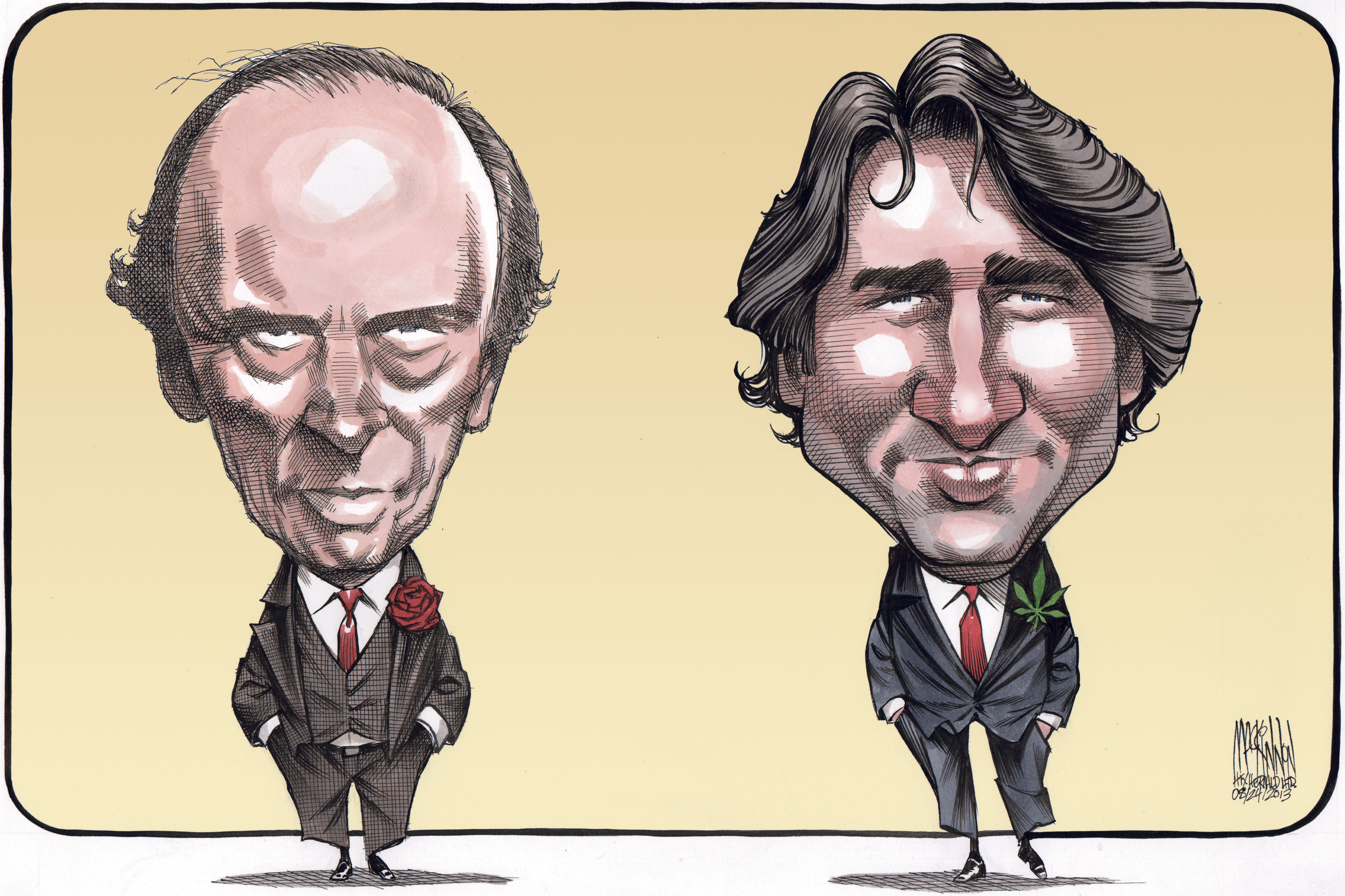Browse "Politics & Law"
-
Article
Prime Suspects: Canada's Prime Ministers, Caricatured
In this exhibit of political artwork, cartoonist Bruce MacKinnon marks 2017, Canada's 150 birthday, with caricatures of the country's 23 prime ministers.
"https://d2ttikhf7xbzbs.cloudfront.net/media/media/3a8d9570-4ef0-49a2-b4a8-142a6d4845e2.jpg" // resources/views/front/categories/view.blade.php
https://d2ttikhf7xbzbs.cloudfront.net/media/media/3a8d9570-4ef0-49a2-b4a8-142a6d4845e2.jpg
-
Article
Prison
Prison, as a term meaning a place in which people are kept in captivity, covers a variety of institutions in Canada. Jails, commonly called detention or remand centres, are used to incarcerate persons awaiting trial or those sentenced for short terms.
"https://development.thecanadianencyclopedia.ca/images/tce_placeholder.jpg?v=e9dca980c9bdb3aa11e832e7ea94f5d9" // resources/views/front/categories/view.blade.php
https://development.thecanadianencyclopedia.ca/images/tce_placeholder.jpg?v=e9dca980c9bdb3aa11e832e7ea94f5d9
-
Article
Prison Ships in Canada: A Little-Known Story
On 15 July 1940, an unusual vessel docked at the Port of Québec, and a crowd gathered to greet the new arrival. The small craft used for patrolling and transportation on the St. Lawrence River at Québec City, the Jeffy Jan II — rechristened HMC Harbour Craft 54 by the young Canadian Navy during the war — was sent to surveil the ship and its sensitive cargo and passengers. The vessel in question was the prison ship MS Sobieski.
"https://d2ttikhf7xbzbs.cloudfront.net/media/media/05a335d9-a323-47e8-8090-059e81d8b8a4.jpg" // resources/views/front/categories/view.blade.php
https://d2ttikhf7xbzbs.cloudfront.net/media/media/05a335d9-a323-47e8-8090-059e81d8b8a4.jpg
-
Article
Prisoner of War Camps in Canada
Canada operated prison camps for interned civilians during the First and Second World Wars, and for 34,000 combatant German prisoners of war (POWs) during the Second World War.
"https://d2ttikhf7xbzbs.cloudfront.net/media/media/cde937a6-33ac-4af0-87d7-4a9323820e13.jpg" // resources/views/front/categories/view.blade.php
https://d2ttikhf7xbzbs.cloudfront.net/media/media/cde937a6-33ac-4af0-87d7-4a9323820e13.jpg
-
Article
Privacy
In a primarily rural society, such as 19th-century Canada, privacy was basically a territorial concept. Today, privacy tends to be defined not only territorially but as the right of individuals to determine when, how and to what extent information about themselves is to be communicated to others.
"https://development.thecanadianencyclopedia.ca/images/tce_placeholder.jpg?v=e9dca980c9bdb3aa11e832e7ea94f5d9" // resources/views/front/categories/view.blade.php
https://development.thecanadianencyclopedia.ca/images/tce_placeholder.jpg?v=e9dca980c9bdb3aa11e832e7ea94f5d9
-
Article
Privy Council
Privy Council is a common name for the King’s Privy Council for Canada. It is also known as His Majesty’s Privy Council for Canada. It was established (as the Queen’s Privy Council for Canada) under the Constitution Act, 1867. Its purpose is to advise the Crown (the reigning monarch).
"https://d2ttikhf7xbzbs.cloudfront.net/1280px-Privy_Council_Office_Metcalfe_Ottawa_491755.jpg" // resources/views/front/categories/view.blade.php
https://d2ttikhf7xbzbs.cloudfront.net/1280px-Privy_Council_Office_Metcalfe_Ottawa_491755.jpg
-
Article
Privy Council Office
The Privy Council Office (PCO) is a prime minister's government department headed by the clerk designated (since 1940) secretary to the Cabinet. It is perhaps the most important and certainly the most senior of the central agencies of government.
"https://d2ttikhf7xbzbs.cloudfront.net/media/media/0f1551ef-6d07-484c-8e51-b818a1e1af7c.jpg" // resources/views/front/categories/view.blade.php
https://d2ttikhf7xbzbs.cloudfront.net/media/media/0f1551ef-6d07-484c-8e51-b818a1e1af7c.jpg
-
Article
Probation and Parole
Probation is a correctional method under which convicted offenders are supervised in the community instead of imprisonment, or after a period of imprisonment has been served.
"https://development.thecanadianencyclopedia.ca/images/tce_placeholder.jpg?v=e9dca980c9bdb3aa11e832e7ea94f5d9" // resources/views/front/categories/view.blade.php
https://development.thecanadianencyclopedia.ca/images/tce_placeholder.jpg?v=e9dca980c9bdb3aa11e832e7ea94f5d9
-
Article
Procedural Law
Procedural Law encompasses legal rules governing the process for settlement of disputes (criminal and civil). In contrast, SUBSTANTIVE LAW sets out the rights and obligations of members of society. Procedural and substantive law are complementary.
"https://development.thecanadianencyclopedia.ca/images/tce_placeholder.jpg?v=e9dca980c9bdb3aa11e832e7ea94f5d9" // resources/views/front/categories/view.blade.php
https://development.thecanadianencyclopedia.ca/images/tce_placeholder.jpg?v=e9dca980c9bdb3aa11e832e7ea94f5d9
-
"https://development.thecanadianencyclopedia.ca/images/tce_placeholder.jpg?v=e9dca980c9bdb3aa11e832e7ea94f5d9" // resources/views/front/categories/view.blade.php
https://development.thecanadianencyclopedia.ca/images/tce_placeholder.jpg?v=e9dca980c9bdb3aa11e832e7ea94f5d9
-
"https://development.thecanadianencyclopedia.ca/images/tce_placeholder.jpg?v=e9dca980c9bdb3aa11e832e7ea94f5d9" // resources/views/front/categories/view.blade.php
https://development.thecanadianencyclopedia.ca/images/tce_placeholder.jpg?v=e9dca980c9bdb3aa11e832e7ea94f5d9
-
Article
Professional Orders
Over the past 50 years, Québec has developed a professional system that has gradually consolidated its most important orders according to the size of their memberships and the nature of the their acts, which are often exclusive.
"https://development.thecanadianencyclopedia.ca/images/tce_placeholder.jpg?v=e9dca980c9bdb3aa11e832e7ea94f5d9" // resources/views/front/categories/view.blade.php
https://development.thecanadianencyclopedia.ca/images/tce_placeholder.jpg?v=e9dca980c9bdb3aa11e832e7ea94f5d9
-
"https://development.thecanadianencyclopedia.ca/images/tce_placeholder.jpg?v=e9dca980c9bdb3aa11e832e7ea94f5d9" // resources/views/front/categories/view.blade.php
https://development.thecanadianencyclopedia.ca/images/tce_placeholder.jpg?v=e9dca980c9bdb3aa11e832e7ea94f5d9
-
Article
Progressive Party
The Progressive Party was formed in 1920 when Ontario and prairie farmers on the Canadian Council of Agriculture united with dissident Liberals led by Thomas CRERAR, who resigned from the federal Cabinet in 1919 opposing high tariffs.
"https://d2ttikhf7xbzbs.cloudfront.net/media/media/5ab971b0-e7b8-4473-909a-0448790416a3.jpg" // resources/views/front/categories/view.blade.php
https://d2ttikhf7xbzbs.cloudfront.net/media/media/5ab971b0-e7b8-4473-909a-0448790416a3.jpg
-
Article
Prohibition in Canada
Prohibition in Canada came about as a result of the temperance movement. It called for moderation or total abstinence from alcohol, based on the belief that drinking was responsible for many of society’s ills. The Canada Temperance Act (Scott Act) of 1878 gave local governments the “local option” to ban the sale of alcohol. Prohibition was first enacted on a provincial basis in Prince Edward Island in 1901. It became law in the remaining provinces, as well as in Yukon and Newfoundland, during the First World War. Liquor could be legally produced in Canada (but not sold there) and legally exported out of Canadian ports. Most provincial laws were repealed in the 1920s. PEI was the last to give up the “the noble experiment” in 1948.
"https://d2ttikhf7xbzbs.cloudfront.net/media/media/c0f20001-e566-4ebf-9c88-f1a5ae278291.jpg" // resources/views/front/categories/view.blade.php
https://d2ttikhf7xbzbs.cloudfront.net/media/media/c0f20001-e566-4ebf-9c88-f1a5ae278291.jpg
